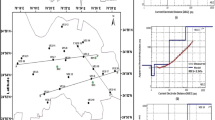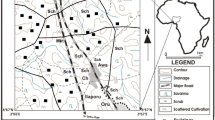Abstract
Surface geophysical methods were used to determine the locations of fracture zones in part of the hard rock area in Sonebhadra District of Uttar Pradesh, India. The survey comprises three DC resistivity profile using the gradient profiling technique and ten very low frequency electromagnetic (VLF-EM) traverses profiles. The methods were used over survey lines extending between 200 and 400 m; the results were correlated to locate fracture zones for the purpose of groundwater exploration. Qualitative interpretation of the VLF-EM was carried out using Fraser and Karous–Hjelt filters. The result of the interpretation revealed a number of subsurface zones with high real component current density that defines the potential subsurface features (probably fracture zones). The subsurface feature concurred with the low resistive zones indentified from the gradient resistivity profiling. The zones where further inferred quantitatively using data obtained from DC resistivity sounding at some selected anomalous points. The result obtained proves the efficiency of integrating both methods in detecting fractures zones in hard rock area.





Similar content being viewed by others
References
Al-Tarazi E, Abu Rajab J, Al-Naqa A, El-Waheidi M (2008) Detecting leachate plumes and groundwater pollution at Ruseifa municipal landfill utilizing VLF-EM method. J Appl Geophys 65:121–131
Amaresh KS, Prakash SR (2003) An integreted approach of remote sensing, geophysics and GIS to evaluation of groundwater potentiality of Ojhala Subwatershed, Mirzapur District, U.P., India. Map India Conference, 2003. http://www.GISdevelopment.net. Accessed 29 Oct 2012
Ariyo SO, Adeyemi GO, Oyebamiji AO (2009) Electromagnetic VLF survey for groundwater development in contact terrain; a case study of Ishara-reno, South Western Nigeria. J Appl Sci Res 5(9):1239–1246
Bhattacharya BB, Dutt I (1982) Depth of investigation studies for gradient arrays over homogeneous isotropic half-space. Geophys 47(8):1198–1203
Bhattacharyya A (1996) Recent advances in Vindhyan geology. Geol Soc India Memoir 36:331
Bose PK, Sarkar S, Chakrabarty S, Banerjee S (2001) Overview of Meso- to Neoproterozoic evolution of the Vindhyan basin, Central India. J Sediment Geol 142:395–419
Fraser DC (1969) Contouring of VLF-EM data. Geophys 34:958–967
Gnaneshwar P, Shivaji A, Srinivas Y, Jettaiah P, Sundararajan N (2010) Very-low-frequency electromagnetic (VLF-EM) measurements in the Schrimacheroasen area, East Antarctica. Polar Sci 5(1):11–19
Gustafsson P (1993) Satellite data and GIS as a tool in groundwater exploration in semi-arid area. Publication A 74. Chalmers University of Technology, Gothenburg
Hubbard SS (2011) Hydrogeophysics. Lawrence Berkeley National Laboratory, Berkeley
Karous M, Hjelt SE (1983) Linear filtering of VLF dip angle measurements. Geophys Prospect 31:782–794
Kearey P, Brooks M (1984) An introduction to geophysical exploration. Blackwell, Oxford
Keller GV, Frischknecht FC (1966) Electrical methods in geophysical prospecting. Pergamon, New York
Koefoed O (1979) Geosounding principles, 1: resistivity sounding measurements. Elsevier, Amsterdam
Krishnan MS (1982) Geology of India and Burma, 6th edn. CBS, New Delhi
Kunetz G (1966) Principles of direct current resistivity prospecting. Borntraeger, Berlin
McNeill JD, Labson VF (1991) Geological mapping using VLF radio fields. In: Nabighian M (ed) Electromagnetic methods in applied geophysics, vol 2, part B. Society of Exploration Geophysics, Tulsa, pp 521–640
Meijerink AMJ (2007) Remote sensing application to groundwater. IHP-VI, series on groundwater, no. 16. UNESCO, France
Mishra M, Sen M (2010) Geochemical signatures of Mesoproterozoic silica-clastic rocks of the kaimur group of the Vindhyan Supergroup, Central India. Chin J Geochem 21:021–032
Ogilvy RD, Lee AC (1991) Interpretation of VLF-EM in-phase data using current density pseudosections. Geophys Prospect 39:567–580
Orellana E, Mooney HM (1966) Master tables and curves for vertical electrical sounding over layered structures. Inerciencia Costanilla de Los Angeles, Madrid
Pirttijarvi M (2004) Karous–Hjelt and Fraser filtering of VLF measurements. Manual of KHFFILT program. University of Oulu, Oulu
Powers C J, Singha K, Haeni FP (1999) Integration of surface geophysical methods for fractured detection in bedrock at Mirror Lake, New Hampshire. In: Monoganwalp D W, Buxton H T (eds) U.S Geological toxic substances hydrology program proceedings of the Technical meeting, Charleston, South Carolina, USGS Water Resources Investigation Report 99-04018C 3: pp 757–768
Schluz R (1985) Interpretation and depth of investigation of gradient measurements in direct current geoelectrics. Geophy Prospect 33:1240–1253
Sharma PV (1997) Environmental and engineering geophysics. Cambridge University Press, New York
Shettigara KV, Peterson FL (1985) Electrical resistivity investigation of Schofield high-level water body O’ahu, Hawaii. Technical Report No. 69. Water Resource Research Centre. University of Hawaii at Manoa, Honolulu
Srigutomo W, Harja A, Sutarno D, Kagiyama T (2005) VLF data analysis through transformation into resistivity value: application to synthetic and field data. Indones J Phys 16(4):127–136
Telford WM, Geldart LP, Sheriff RE (1990) Applied geophysics, 2nd edn. Cambridge University Press, Cambridge
Teme SC, Oni SF (1991) Detection of groundwater flow in fracture media through remote sensing technique—some Nigerian cases. J Afr Earth Sci 12(3):461–466
Vander Velpen BPA (1988) WinResist version 1.0 M.Sc Research project. ITC, Delft, Nertherlands
Yadav GS, Singh SK (2007) Integrated resistivity survey for the delineating of fractures for ground water exploration in hard rock areas. J Appl Geophys 62(3):301–312
Yadav GS, Singh SK (2008) Gradient profiling for the investigation of ground water saturated fractures in hard rocks of Uttar Pradesh, India. Hydrogeol J 16:363–372
Acknowledgments
The authors are grateful to the Department of Geophysics, Banaras Hindu University, for providing the necessary facilities required for the survey and also thankful to Mr. Anjani K. Tiwari for his assistance during the data acquisition. We appreciate with profound gratitude the valuable and thoughtful suggestions given by the reviewers and editor which has significantly improved the standard of this paper. Financial support given to the first author by Adamawa State University, Mubi is duly acknowledged.
Author information
Authors and Affiliations
Corresponding author
Rights and permissions
About this article
Cite this article
Ndatuwong, L.G., Yadav, G.S. Identifications of fractured zones in part of hard rock area of Sonebhadra District, U.P., India using integrated surface geophysical method for groundwater exploration. Arab J Geosci 7, 1781–1789 (2014). https://doi.org/10.1007/s12517-013-0880-y
Received:
Accepted:
Published:
Issue Date:
DOI: https://doi.org/10.1007/s12517-013-0880-y




